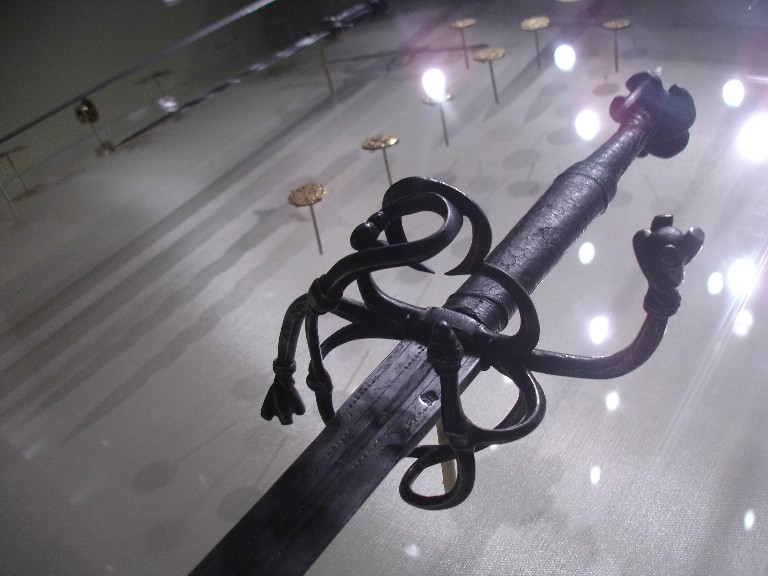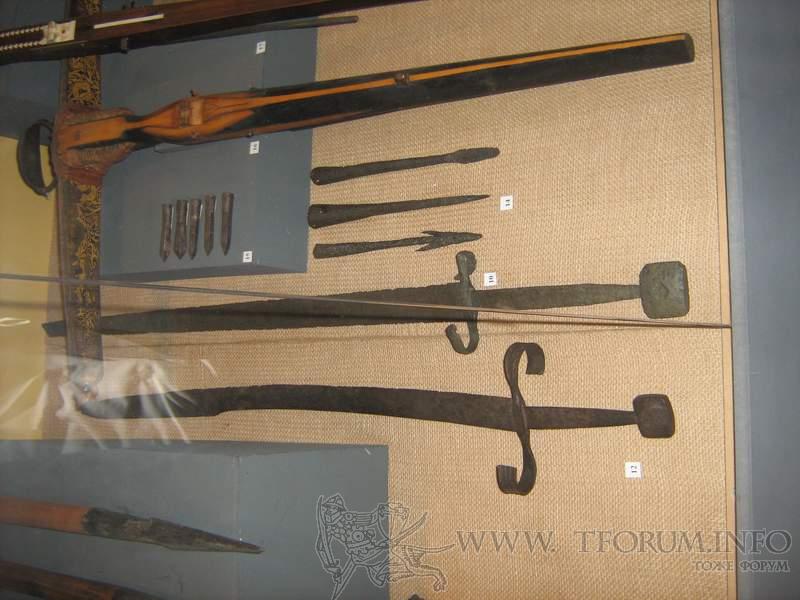| Author |
Message |
|
Jim Mearkle
|
 Posted: Fri 24 Jul, 2009 4:18 pm Post subject: Recurved sword cross guards Posted: Fri 24 Jul, 2009 4:18 pm Post subject: Recurved sword cross guards |
 |
|
While admiring Tinker's swords (http://tinkerswords.com/Page%203.html) , I noticed the guards on the Irish bastard and the Type XVIIIa Bastardsword curve in opposite directions. The Irish has an "S" bend, as viewed from the pommel end. The XVIIIa has a "Z" bend.
So, now I'm curious: Is either one more prevalent in surviving antiques? Does one have an advantage over the other when sparring?
Jim
|
|
  |
 |
Bill Grandy
myArmoury Team


|
 Posted: Fri 24 Jul, 2009 5:59 pm Post subject: Re: Recurved sword cross guards Posted: Fri 24 Jul, 2009 5:59 pm Post subject: Re: Recurved sword cross guards |
 |
|
| Jim Mearkle wrote: | While admiring Tinker's swords (http://tinkerswords.com/Page%203.html) , I noticed the guards on the Irish bastard and the Type XVIIIa Bastardsword curve in opposite directions. The Irish has an "S" bend, as viewed from the pommel end. The XVIIIa has a "Z" bend.
So, now I'm curious: Is either one more prevalent in surviving antiques? Does one have an advantage over the other when sparring? |
I've noticed more originals that have an "S" bend than a "Z" bend, but I've definately seen both. And just because I've noticed more of the "S" shape doesn't actually mean this is true overall, it just is a reflection of the samples I've seen. There's no actual advantage or disadvantage to having one over the other (or having a straight guard, for that matter).
HistoricalHandcrafts.com
-Inspired by History, Crafted by Hand
"For practice is better than artfulness. Your exercise can do well without artfulness, but artfulness is not much good without the exercise.” -anonymous 15th century fencing master, MS 3227a
|
|
   |
 |
|
Eric W. Norenberg
|
 Posted: Fri 24 Jul, 2009 9:21 pm Post subject: Re: Recurved sword cross guards Posted: Fri 24 Jul, 2009 9:21 pm Post subject: Re: Recurved sword cross guards |
 |
|
| Bill Grandy wrote: | | I've noticed more originals that have an "S" bend than a "Z" ... |
I've always wondered if the less-common "Z" bend was to acommodate less-common left-handed swordsmen. If one is in the habit of running the thumb of the lead hand over the cross onto the blade (to aid with blade alignment?), then an "S" bend might run the end of the cross into one's wrist, if the cross were long enough, in the case of a southpaw. Maybe?
-Eric
|
|
  |
 |
Bill Grandy
myArmoury Team


|
 Posted: Fri 24 Jul, 2009 10:16 pm Post subject: Re: Recurved sword cross guards Posted: Fri 24 Jul, 2009 10:16 pm Post subject: Re: Recurved sword cross guards |
 |
|
| Eric W. Norenberg wrote: | | Bill Grandy wrote: | | I've noticed more originals that have an "S" bend than a "Z" ... |
I've always wondered if the less-common "Z" bend was to acommodate less-common left-handed swordsmen. If one is in the habit of running the thumb of the lead hand over the cross onto the blade (to aid with blade alignment?), then an "S" bend might run the end of the cross into one's wrist, if the cross were long enough, in the case of a southpaw. Maybe?
-Eric |
I used to wonder that, too (though I assumed it would be "left handed" aesthetically, not functionally), but I've come to realize that there are a number of complex hilts that are clearly right handed, but have the "Z" bend. Attached below is one from the Smithsonian collection. Every single sword I've seen of this style has the exact same "Z" bend.
 Attachment: 90.33 KB Attachment: 90.33 KB

HistoricalHandcrafts.com
-Inspired by History, Crafted by Hand
"For practice is better than artfulness. Your exercise can do well without artfulness, but artfulness is not much good without the exercise.” -anonymous 15th century fencing master, MS 3227a
|
|
   |
 |
|
Matthew P. Adams
|
 Posted: Sun 29 Nov, 2015 9:43 am Post subject: Posted: Sun 29 Nov, 2015 9:43 am Post subject: |
 |
|
I've been doing a little googling about recurve cross guards and haven't found a lot, hence bringing back this thread.
I had a recurve cross put on an Atrim blade a couple years ago, and I did it basically because I thought the Albion Munich looks just amazing. It turned me on to Durers work and I just really like that style.
But what's it do??
I've been practicing Fiore Armizare for 6 (?) years now, and it eludes me.
Is it more protective, or just decorative? Is it a precursor to the complex hilt?
Does anyone practice with a recurve crossed rebate who could lend some experience?
"We do not rise to the level of our expectations. We fall to the level of our training" Archilochus, Greek Soldier, Poet, c. 650 BC
|
|
  |
 |
Mikko Kuusirati

|
 Posted: Sun 29 Nov, 2015 11:00 am Post subject: Posted: Sun 29 Nov, 2015 11:00 am Post subject: |
 |
|
This may be anecdotal, but from personal experience I think the direction of the curve has mostly to do with wearing the sword: if the rear quillon of a sheathed sword curves inward it will tend to keep prodding you. So because of that, IMO, swords for right-handed swordsmen (which of course dominate the archaeological record) tend to have crosses that curve clockwise, like an S, when viewed from the pommel end.
"And sin, young man, is when you treat people like things. Including yourself. That's what sin is."
— Terry Pratchett, Carpe Jugulum
|
|
  |
 |
|
Luka Trkanjec
Location: Zagreb, Croatia Joined: 19 May 2015
Posts: 8
|
 Posted: Sun 29 Nov, 2015 1:14 pm Post subject: Posted: Sun 29 Nov, 2015 1:14 pm Post subject: |
 |
|
The schiavonesca swords of south-eastern Europe have sharply recurved cross-guards (type 12 in Oakeshott classification, I think), and in vast majority of surviving examples, this curvature almost as a rule goes in clockwise direction (from left to right, like an S) when viewed from the pommel. However, there are a couple of examples where the curvature is in opposite direction (right to left, like Z).
This indicates that the curvature of the guard followed the use of right (majority) or left (minority) hand on the sword. And the reason this was done, IMHO, was to give some additional protection for the fingers. When the cross-guard curves strongly in the direction of your fingers, this works almost as if you have a side-ring on the cross, but is obviously easier to make and requires less material.
Again, in the cases of schavionesca swords of south-eastern Europe, there are couple of examples where the cross-guard is very messily bent, almost as if this was done in a hurry on an existing sword that before had straight cross. Take look at the upper sword in this picture, for instance:

All this leads me to the conclusion that sometime, say, during the latter half of 14th century, European swordsmen started to worry about additional hand protection. The first and easiest step to achieve this was to simply bend the handles of the cross-guards on the existing swords, following the natural shape of your primary hand. This then quickly became a fashion that catch on, and very soon swords were being produced with such S-shapped (or Z-shapped) cross-guards, even if for purely aesthetic reasons.
|
|
   |
 |
|
Matthew P. Adams
|
 Posted: Mon 21 Dec, 2015 8:41 am Post subject: Posted: Mon 21 Dec, 2015 8:41 am Post subject: |
 |
|
My Fiore group in Boston has come up with a theory that I've been exploring. It seems to work consistently. If you're in a bind, and your opponent slides his blade to the cross and thrusts, one can role into Bicorno and lock his blade in your guard and safely counter thrust. A curved guard makes this a lot more successful as well as safer.
"We do not rise to the level of our expectations. We fall to the level of our training" Archilochus, Greek Soldier, Poet, c. 650 BC
|
|
  |
 |
|
|
You cannot post new topics in this forum
You cannot reply to topics in this forum
You cannot edit your posts in this forum
You cannot delete your posts in this forum
You cannot vote in polls in this forum
You cannot attach files in this forum
You can download files in this forum
|
All contents © Copyright 2003-2025 myArmoury.com — All rights reserved
Discussion forums powered by phpBB © The phpBB Group
Switch to the Basic Low-bandwidth Version of the forum
|

